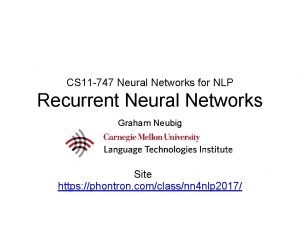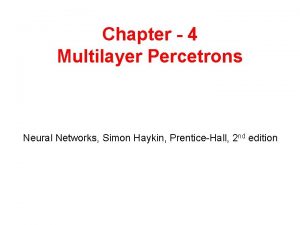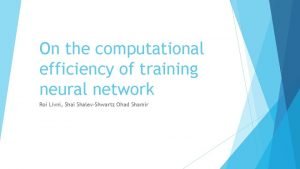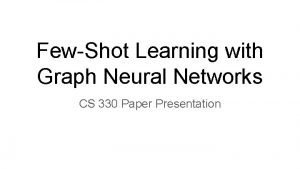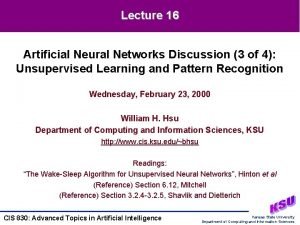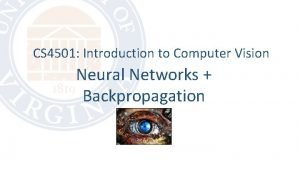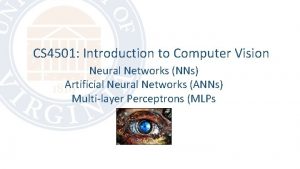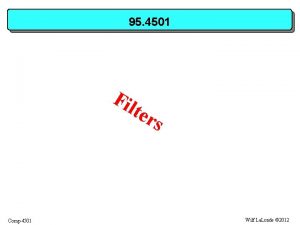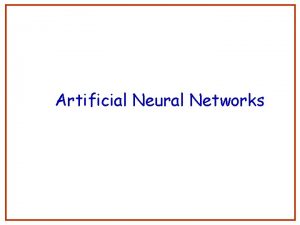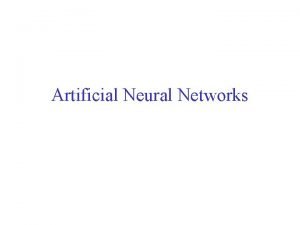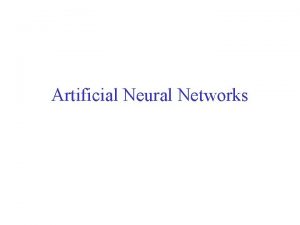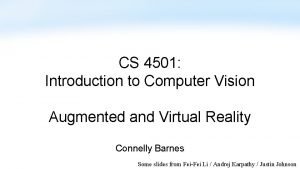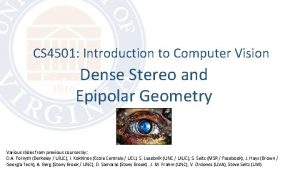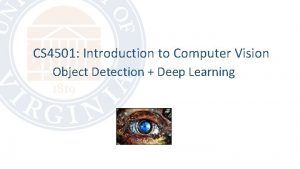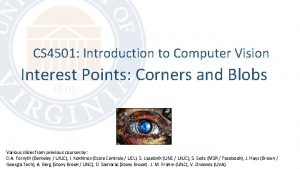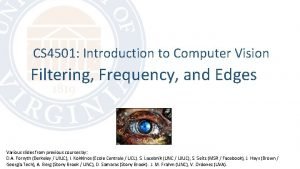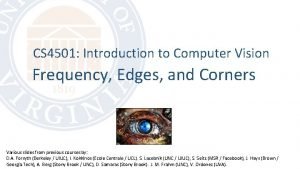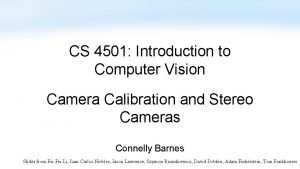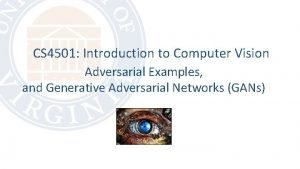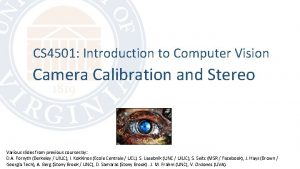CS 4501 Introduction to Computer Vision Neural Networks


































- Slides: 34

CS 4501: Introduction to Computer Vision Neural Networks + Convolutional Neural Networks

Last Class • Global Features • The perceptron model • Neural Networks – multilayer perceptron model (MLP) • Backpropagation

Today’s Class • Neural Networks – multilayer perceptron model (MLP) • Backpropagation • Convolutional Neural Networks

Perceptron Model Frank Rosenblatt (1957) - Cornell University More: https: //en. wikipedia. org/wiki/Perceptron Activation function

Perceptron Model Frank Rosenblatt (1957) - Cornell University !? More: https: //en. wikipedia. org/wiki/Perceptron

Perceptron Model Frank Rosenblatt (1957) - Cornell University More: https: //en. wikipedia. org/wiki/Perceptron Activation function

Activation Functions Step(x) Tanh(x) Sigmoid(x) Re. LU(x) = max(0, x)

Pytorch - Perceptron

Two-layer Multi-layer Perceptron (MLP) ”hidden" layer Loss / Criterion

Forward pass

Backward pass Grad. Params Grad. Inputs

Pytorch – Two-layer MLP + Regression

Pytorch – Two-layer MLP + Log. Softmax # of Hidden Units

Pytorch – Two-layer MLP + Log. Softmax + Negative Likelihood Loss

Bookmark Opportunity!

SGD training code (Project 4)

Convolutional (Neural) Networks

Convolutional Layer

Convolutional Layer

Convolutional Layer Weights

Convolutional Layer Weights 4

Convolutional Layer Weights 4 1

Convolutional Layer (with 4 filters) Input: 1 x 224 weights: 4 x 1 x 9 x 9 Output: 4 x 224 if zero padding, and stride = 1

Convolutional Layer (with 4 filters) Input: 1 x 224 weights: 4 x 1 x 9 x 9 Output: 4 x 112 if zero padding, but stride = 2

Convolutional Layer in Torch k. W Input Output n. Output. Plane x k. H n. Input. Plane (e. g. 3 for RGB inputs) n. Output. Plane (equals the number of convolutional filters for this layer)

Convolutional Layer in Keras Convolution 2 D(n. Output. Plane, k. W, k. H, input_shape = (3, 224), subsample = 2, border_mode = valid) k. W Input Output n. Output. Plane x k. H n. Input. Plane (e. g. 3 for RGB inputs) n. Output. Plane (equals the number of convolutional filters for this layer)

Convolutional Layer in pytorch kernel_size Input Output out_channels x kernel_size in_channels (e. g. 3 for RGB inputs) out_channels (equals the number of convolutional filters for this layer)

Convolutional Network: Le. Net

Le. Net in Pytorch

Spatial. Max. Pooling Layer take the max in this neighborhood 8 8 8

Convolutional Layers as Matrix Multiplication https: //petewarden. com/2015/04/20/why-gemm-is-at-the-heart-of-deep-learning/

Convolutional Layers as Matrix Multiplication https: //petewarden. com/2015/04/20/why-gemm-is-at-the-heart-of-deep-learning/

Convolutional Layers as Matrix Multiplication Pros? Cons? https: //petewarden. com/2015/04/20/why-gemm-is-at-the-heart-of-deep-learning/

Questions? 34
 Neural network matlab toolbox
Neural network matlab toolbox Cnn ppt for image classification
Cnn ppt for image classification Introduction to convolutional neural networks
Introduction to convolutional neural networks Explain virtual circuit and datagram network
Explain virtual circuit and datagram network Backbone networks in computer networks
Backbone networks in computer networks Cs766
Cs766 Visualizing and understanding convolutional networks
Visualizing and understanding convolutional networks Vc bound
Vc bound Freed et al 2001 ib psychology
Freed et al 2001 ib psychology Audio super resolution using neural networks
Audio super resolution using neural networks Convolutional neural networks for visual recognition
Convolutional neural networks for visual recognition Image style transfer using convolutional neural networks
Image style transfer using convolutional neural networks Nvdla
Nvdla Mippers
Mippers Least mean square algorithm in neural network
Least mean square algorithm in neural network Pixelrnn
Pixelrnn Neural networks for rf and microwave design
Neural networks for rf and microwave design 11-747 neural networks for nlp
11-747 neural networks for nlp Neural networks simon haykin
Neural networks simon haykin Sparse convolutional neural networks
Sparse convolutional neural networks On the computational efficiency of training neural networks
On the computational efficiency of training neural networks Threshold logic unit in neural network
Threshold logic unit in neural network Fuzzy logic lecture
Fuzzy logic lecture Lmu cis
Lmu cis Few shot learning with graph neural networks
Few shot learning with graph neural networks Deep forest: towards an alternative to deep neural networks
Deep forest: towards an alternative to deep neural networks Convolutional neural networks
Convolutional neural networks Neuraltools neural networks
Neuraltools neural networks Gated recurrent unit in deep learning
Gated recurrent unit in deep learning Predicting nba games using neural networks
Predicting nba games using neural networks Neural networks and learning machines
Neural networks and learning machines The wake-sleep algorithm for unsupervised neural networks
The wake-sleep algorithm for unsupervised neural networks Bharath subramanyam
Bharath subramanyam Convolutional neural network alternatives
Convolutional neural network alternatives Terminator 2 neural net processor
Terminator 2 neural net processor

















